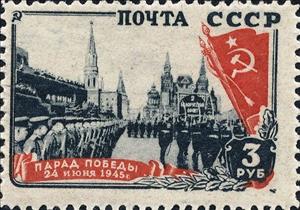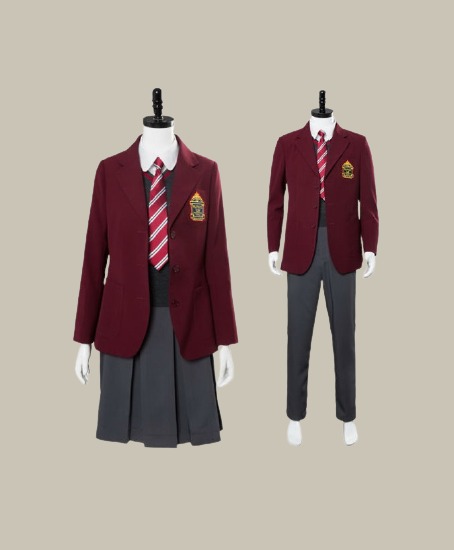Stamp: Victory parade on Red Square (Soviet Union, USSR 1946)
Victory parade on Red Square (Soviet Union, USSR 1946)
01 January (Soviet Union, USSR ) within release 10th Death Anniversary of Maxim Gorky goes into circulation Stamp Victory parade on Red Square face value 3 Russian ruble
| Stamp Victory parade on Red Square in catalogues | |
|---|---|
| Michel: | Mi:SU 1013 |
Stamp is horizontal format.
Also in the issue 10th Death Anniversary of Maxim Gorky:
- Stamp - Medal "For Valiant Labour in the Great Patriotic War" face value 30;
- Stamp - Medal "For Victory over Germany in the Great Patriotic War" face value 30;
- Stamp - Medal "For Valiant Labour in the Great Patriotic War" face value 60;
- Stamp - Medal "For Victory over Germany in the Great Patriotic War" face value 60;
- Stamp - Long Live Our Victory! face value 60;
- Stamp - Coat of Arms of the Soviet Union face value 30;
- Stamp - Spasskaya Tower of the Moscow Kremlin face value 45;
- Stamp - Coat of Arms of the Soviet Union face value 60;
- Stamp - Artillery on Red Square face value 60;
- Stamp - Artillery on Red Square face value 2;
- Stamp - Victory parade on Red Square face value 3;
- Stamp - Pafnuty L. Chebyshev (1821-1894), Russian mathematician face value 30;
- Stamp - Pafnuty L. Chebyshev (1821-1894), Russian mathematician face value 60;
- Stamp - Order of Lenin face value 60;
- Stamp - Medal "Hammer and Sickle" face value 60;
- Stamp - Order of the Red Banner of Labour face value 60;
- Stamp - Order of the Red Star face value 60;
- Stamp - Gold Star medal face value 60;
- Stamp - Order of the Badge of Honour face value 60;
- Stamp - Order of the Red Banner face value 60;
- Stamp - Medal for Battle Merit face value 60;
- Stamp - Medal "For the Defence of the Caucasus" face value 60;
- Stamp - Medal "For Labour Valour" face value 60;
- Stamp - Marshal's Star face value 60;
- Stamp - Medal "For Courage" face value 60;
- Stamp - Medal "For the Defence of the Soviet Transarctic" face value 60;
- Stamp - Medal "For the Defence of Moscow" face value 60;
- Stamp - Medal "For Distinguished Labour" face value 60;
- Stamp - Mikhail I. Kalinin (1875-1946), Soviet statesman face value 20;
- Stamp - Sukhumi face value 15;
- Stamp - Gagry face value 30;
- Stamp - Sochi. Riviera Park face value 30;
- Stamp - Novy Afon face value 45;
- Stamp - Maxim Gorky (1868-1936), Russian author face value 30;
- Stamp - Maxim Gorky (1868-1936), Russian author face value 60;
- Stamp - Athletes carrying flags and portrait of Joseph Stalin face value 30;
- Stamp - Medal "For the Defence of the Caucasus" face value 1;
- Stamp - Ivan the Great Bell Tower face value 5;
- Stamp - Bolshoi Theatre face value 10;
- Stamp - Hotel Moskva face value 15;
- Stamp - Sverdlov Square face value 20;
- Stamp - View of the Kremlin from the Moscow River face value 45;
- Stamp - View of Red Square. Saint Basil's Cathedral face value 60;
- Stamp - Monument of Minin and Pozharsky against the Spasskaya Tower face value 1;
- Stamp - Column of tanks on Red Square, Moscow face value 30;
- Stamp - Column of tanks on Red Square, Moscow face value 60;
- Stamp - A wheat sheaf. Combine harvester. face value 5;
- Stamp - Oil field and rigs face value 10;
- Stamp - Transportation of coal. Miner face value 15;
- Stamp - In the steel manufactory face value 20;
- Stamp - Steelworkers at the blast furnaces face value 30;
- Stamp - Soviet stamps on contour map of the USSR face value 15;
- Stamp - 1st Soviet Postage Stamp face value 30;
- Stamp - Images of Soviet stamps face value 60;
- Stamp - Bas-relief "Lenin and Stalin". Spasskaya Tower face value 30;
- Stamp - Bas-relief "Lenin and Stalin". Spasskaya Tower face value 30;
- Stamp - Bas-relief "Lenin and Stalin". Spasskaya Tower face value 30;
- Stamp - Nikolay A. Nekrasov (1821-1878), Russian poet face value 30;
- Stamp - Nikolay Nekrasov (1821-1878), Russian poet face value 60;
- Stamp - The right side of the badge "Laureate of Stalin Prize" face value 30;
- Stamp - Reconstrusting Dam of Dnieper Hydroelectric Station face value 30;
- Stamp - Reconstrusting Dam of Dnieper Hydroelectric Station face value 60;
Stamp Victory parade on Red Square it reflects the thematic directions:
A flag is a piece of fabric (most often rectangular or quadrilateral) with a distinctive design that is used as a symbol, as a signaling device, or as decoration. The term flag is also used to refer to the graphic design employed, and flags have since evolved into a general tool for rudimentary signalling and identification, especially in environments where communication is similarly challenging (such as the maritime environment where semaphore is used). National flags are patriotic symbols with varied wide-ranging interpretations, often including strong military associations due to their original and ongoing military uses. Flags are also used in messaging, advertising, or for other decorative purposes. The study of flags is known as vexillology, from the Latin word vexillum, meaning flag or banner.
A uniform is a variety of costume worn by members of an organization while usually participating in that organization's activity. Modern uniforms are most often worn by armed forces and paramilitary organizations such as police, emergency services, security guards, in some workplaces and schools, and by inmates in prisons. In some countries, some other officials also wear uniforms in their duties; such is the case of the Commissioned Corps of the United States Public Health Service or the French prefects. For some organizations, such as police, it may be illegal for non-members to wear the uniform.
Architecture (Latin architectura, from the Greek ἀρχιτέκτων arkhitekton "architect", from ἀρχι- "chief" and τέκτων "builder") is both the process and the product of planning, designing, and constructing buildings and other physical structures. Architectural works, in the material form of buildings, are often perceived as cultural symbols and as works of art. Historical civilizations are often identified with their surviving architectural achievements.
An army, ground force or land force is an armed force that fights primarily on land. In the broadest sense, it is the land-based military branch, service branch or armed service of a nation or country. It may also include aviation assets by possessing an army aviation component. Within a national military force, the word army may also mean a field army.
A town square (or public square, urban square, city square or simply square), also called a plaza or piazza, is an open public space commonly found in the heart of a traditional town or city, and which is used for community gatherings. Related concepts are the civic center, the market square and the village green.




